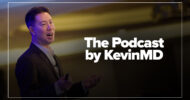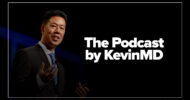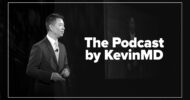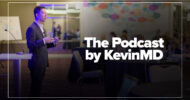Subscribe to The Podcast by KevinMD. Watch on YouTube. Catch up on old episodes!
Physician executive Laura Kohlhagen discusses her article, “Here’s what providers really need in a modern EHR.” She argues that since electronic health records were originally designed for billing and compliance, they have created disjointed workflows, cognitive fatigue, and clinician burnout. Laura explains how modern AI technologies are finally transforming EHRs into the clinical tools they were always meant to be. She details how ambient listening technology automates documentation, allowing physicians to focus on patients instead of computers, while predictive analytics improve operational efficiency and help identify at-risk patients. AI is also solving long-standing interoperability challenges by normalizing and summarizing data from different sources. For patients, AI-powered platforms can offer proactive engagement and personalized education based on social determinants of health. The key takeaway is that while AI offers a path away from burnout and toward better care, it must be implemented responsibly, with clinical usability and patient safety as the highest priorities.
Careers by KevinMD is your gateway to health care success. We connect you with real-time, exclusive resources like job boards, news updates, and salary insights, all tailored for health care professionals. With expertise in uniting top talent and leading employers across the nation’s largest health care hiring network, we’re your partner in shaping health care’s future. Fulfill your health care journey at KevinMD.com/careers.
VISIT SPONSOR → https://kevinmd.com/careers
Discovering disability insurance? Pattern understands your concerns. Over 20,000 doctors trust us for straightforward, affordable coverage. We handle everything from quotes to paperwork. Say goodbye to insurance stress – visit Pattern today at KevinMD.com/pattern.
VISIT SPONSOR → https://kevinmd.com/pattern
SUBSCRIBE TO THE PODCAST → https://www.kevinmd.com/podcast
RECOMMENDED BY KEVINMD → https://www.kevinmd.com/recommended
Transcript
Kevin Pho: Hi, and welcome to the show. Subscribe at KevinMD.com/podcast. Today we welcome Laura Kohlhagen. She’s a physician executive, and today’s KevinMD article is, “Here’s what providers really need in a modern EHR.” Laura, welcome to the show.
Laura Kohlhagen: Thank you, Kevin, so much. Happy to be here.
Kevin Pho: All right. So let’s start by briefly sharing your story and then talk about the KevinMD article that you wrote.
Laura Kohlhagen: Sure. Happy to do that. So I’m an OB-GYN by background. Starting out, that was a perfect specialty for me: a great mix of primary care as well as the surgical side and delivering babies and being part of that experience for folks. It was just really exciting. I started practice in Atlanta, Georgia—private practice, very busy—and was quickly overwhelmed by all of the administrative requirements on physicians and, you know, something that we hear about just constantly today. And I really didn’t have the business training to really handle that as efficiently as I needed to.
We also had several billing challenges in the practice. You know, being a very busy practice and having your revenue and your compensation measured by how many patients that you’re seeing. Not seeing those two metrics line up—the number of patients I was seeing and the revenue that that was bringing in—I knew I needed to learn more about the business side of medicine. At that point, I was only two years out of residency, so it was a big decision, you know, going back. And I chose to go back for a health care-focused MBA and learn that business side. While I was there, I really got passionate about the problem-solving, the process improvement education that I received in that program: really, Lean Six Sigma, theory of constraints, and how that applies to health care. So that started me thinking about how I can expand my career beyond the clinical medicine side.
So I really started to get involved in that and passionate about that, and that’s where my career really took a left turn into health IT. And that’s where I’ve been for the past 14 years. So, a lot of my colleagues ask me, “Do you think you wasted all that training?” Absolutely not. All of the burdens that I felt as a new clinician starting private practice, these are things that I now can help clinicians and help drive the way we, the products that we create, the solutions that we create, and making sure to ensure that clinical practice is easier for those clinicians to minimize that burden.
So, I’m really excited to have the opportunity to do that. I now work for an EHR vendor as their CMO, so I have a very heavy influence on the direction we take with our solutions and products and communicate with our clients to make sure that the things that we’re developing align with their needs.
Kevin Pho: So, of course, the electronic health record is one of the biggest health IT challenges that all physicians face, and you have that unique perspective of both the clinical side and the side of the health IT company. So let’s talk about your KevinMD article. What’s it about?
Laura Kohlhagen: Right. So I really wanted to write this article to give clinicians hope. So, what we’ve heard over the past several decades is just the increasing burden and burnout caused and placed on clinicians by the EHR. So a lot of this technology that’s rapidly developing today can have immediate impact on that burden and those challenges. So I wanted to start by just highlighting the historic challenges that I felt as a clinician that when I talk to clinicians every day, these are the challenges that they’re feeling in terms of disconnected workflows.
The EHR, like I said in the article, it wasn’t designed for physicians. Initially, it was designed for billing, for regulatory compliance, and that DNA is still very much there, so clinicians have to modify their natural clinical workflow to fit within the confines of the EHR. So that’s been a big challenge.
Another huge challenge that we see every day is a lack of data interoperability. So historically, EHRs, we all developed our own proprietary software and really were not incentivized to share that data. Organizations, hospitals, and health care organizations also weren’t incentivized to share that data. So you really get siloed pictures of what’s going on with these patients, and that is one of the biggest challenges that we hear from clinicians today. So the combination of lack of data and poor usability, these are things that really contribute to clinician burnout.
And what I see on the tech side is we really have a lot of hope. We’re seeing a lot of improvements that have been promised for years and years and years that are starting to come to fruition that can have significant impacts on clinician workflow, clinician efficiency, and clinician satisfaction. So that’s where I get into talking about AI. Right? Everyone is talking about AI and the use cases in health care.
So, what we’ve seen over the past few years is a real explosion of use cases for this technology. So it started with ambient voice, and really, ambient voice has been around for a while; it just hasn’t been to the point of usability for the clinician every day yet in terms of accuracy of those transcripts, cost. You know, there have been a lot of barriers to adoption, and we’re finally at the tipping point where clinicians can take advantage of some of that technology to ease the documentation burden.
Other things that are happening in the AI space now are chart summarization. So completing discharge summaries, giving me a quick snapshot of what’s been going on with the patient over the past day, or, if I’m in the ambulatory clinic, over the past, since the last time I’ve seen the patient. How we’re modifying alerts to make them more context-aware.
So lessening the standard pop-up alerts that plague us every day and just surfacing information that’s pertinent to what the clinician is doing with that patient at that moment, as well as predictive analytics. So in the past, when I’ve wanted a report created, I’ve had to go to IT and ask for the report and wait a month or two for the report to get created. Now we’re starting to see on-demand dashboards that can be created by end users that don’t have experience and expertise in IT.
So it’s really an exciting time, and it’s no longer “someday.” You know, we’ve talked about AI for years and years and years, but it’s never been real, particularly for health care, which historically has been slower to adopt technology than other industries, but it really today is making a significant impact for clinicians as well as patients.
So I didn’t even touch on the implications for patients in terms of increasing engagement by, let’s say, tailoring education to the specific needs of that patient based on their health condition, their social determinant needs, et cetera, surfacing community resources that can help that patient, and allowing them to interact with the health care organization in a way that makes sense for them.
So that’s why it’s such an exciting time to be in health care right now, and we can really see some real solutions coming to fruition in the short term for both clinicians and patients and health care organizations.
Kevin Pho: So, of course, on my site and on this podcast, we’ve talked about that intersection between AI and health care a lot, and it’s so interesting to get perspectives from people across the health care spectrum.
So you talked about several innovations that AI can give within the context of the EHR. Now, bring that to life with a story. In an ideal situation, tell us the difference it makes to, say, any physician in an office setting, some of these AI tools that you’ve talked about. What would that look like in real life?
Laura Kohlhagen: Absolutely. So all of these manual tasks that I need to complete today, such as documentation, prescription writing, prior authorizations, orders, and referrals, a lot of these things can be automated and just an automatic byproduct of the interaction that I have with the patient. So in specific, we look at applications for both generative AI and agentic AI.
So with generative AI, a great example of that is the ambient voice solutions that you’re seeing today that can capture a conversation and generate a clinical note based on that conversation. So I see so many applications for that and saving physicians’ time and relieving that documentation burden. From an agentic AI perspective, that takes it one step further.
Maybe I’m having a conversation with the patient and the AI solution takes a look at the patient’s chart and says, “Hey, like maybe you want to place an order for this test based on the patient’s condition.” Well, the agentic AI will not only place the order, but it can also complete the prior authorization needed so it can reach out to that payer API, understand what data needs to be completed for that prior authorization, and complete that prior authorization.
So that takes a lot of time and manual mental energy that is today spent by the physicians and it puts it where it needs to be, allowing the physicians to have much more focus on the patient. So I know a big concern that providers have with AI is, “Is this going to replace me?” And absolutely not. AI is a tool. It is a tool that can ease the manual burdens that you have to deal with today to allow you to really focus on what’s going on with the patient. And that’s how I see it.
Kevin Pho: Now, in terms of physicians being replaced, I’ve heard opinion pieces because in order for generative AI tools to work, of course, they’re collecting a lot of data in terms of how physicians speak and how they order. And of course, now with these agentic agents, it’s doing more of the physician tasks. So, to take a contrary opinion, now with increasing amounts of data that these AI companies have, what’s there to say that eventually they can create an experience similar to going to a physician?
Laura Kohlhagen: There is no substitute for that personal connection that physicians have with the patient, that bedside manner, that support that providers and physicians give to their patients. That’s why I see AI. Sure, it has the data, it has the knowledge, but when a patient’s going through a difficult diagnosis, a difficult situation, AI is not going to be their partner through that, through that time, through that diagnosis and that treatment. And that’s where the physician comes in.
So that’s where I see that AI is never going to replace a physician in that respect. It really is a tool to allow physicians to focus on patients. It gives them the full patient picture, whereas today it’s very fragmented, and relieves them of all of the manual tasks and increasing burden that they have today and allows them really to focus whatever the mental energy that they have on the patient and not on fighting with the EHR or fighting with the insurance companies—all of the things that physicians need to do today.
Kevin Pho: Have you heard some of the feedback from physicians as AI takes up more of these tasks? Do you have any metrics, any objective measures that these AI tools do, in fact, save time and reduce physician burnout?
Laura Kohlhagen: Yeah, we’re still fairly early in adoption, but we do have some early outcomes that do suggest time savings, particularly around ambient voice, and I talked about readjusting the focus of physicians away from the EHR and back to the patient.
So some early studies have shown that there’s a 20 percent increase of focused patient time with ambient AI scribes versus traditional documentation. So, that’s just one example. What I’ve actually been surprised by recently is the increased demand and how fast that has occurred in the physician community for these types of tools.
Historically, health care has been slower to adopt new technology. And we’ve really gone from, I would say, really in the past six months, particularly in your community markets and your smaller health care markets, from a level of interest to a demand for these tools because they’re really starting to see that in a real-world situation, in everyday practice, they are making a difference.
Kevin Pho: Is there anything we need to be wary of when it comes to increasing AI in that intersection with health care? Any guardrails or just anything to be careful of?
Laura Kohlhagen: Absolutely. There’s a lot to be careful of, so I’m glad you brought that up. It’s easy to get very excited about AI and all of the possibilities, but we really need to be cautious in terms of what we point AI to do.
So thinking about, you know, is this really a good use case for AI? I don’t want to throw AI at everything. We have to be very considerate about how we train these AI models, particularly around issues of health equity, to make sure that the data that we put in is generating reasonable output that we can use, that we can rely on.
So trust is going to be a big issue. So we have to lay that groundwork so that physicians are able to trust the models that we create and deploy. Otherwise, they’re not going to adopt it. So you must always have clinicians heavily involved whenever you’re thinking about an AI project, deploying tools, particularly around patient-facing AI.
So looking at agents, chatbots that communicate directly with the patient, there always needs to be a human in the middle, so someone who’s reviewing that and making sure that that interaction is appropriate and that the models are not providing information that is inaccurate. That’s why it’s so important that we take this stepwise and we don’t rush into deploying all these AI tools without due diligence and thought.
So anybody who says they’re going to revolutionize health care tomorrow or today with all these AI tools, that’s just not the case. We need to be focused on incremental improvement and focus on use cases where it really makes sense and it’s going to make a big impact for the end users.
Kevin Pho: I mentioned earlier that, of course, you have that dual perspective working for an EHR company and also knowing the clinician side. So when it comes to partnering with a health care technology company, right, there are just going to be so many promises, especially with the advent of AI. From the clinician standpoint or from a hospital standpoint, what are some things that they need to look out for when partnering long-term with a health care technology company?
Laura Kohlhagen: So, you know, don’t get caught up in the AI hype. You really need to understand what that partner is doing around development from an ethical perspective, a security perspective, how they’re training their data models to make sure that the models they’re developing are safe for patient use.
Make sure that they are focusing on the right things. It’s important that your partners take into account clinician input. That’s one of the most important things. And historically, that hasn’t happened with EHRs. You know, that’s why clinicians, we fight with EHRs every day. They weren’t designed for us.
So that needs to change. So going forward, looking for any partner, it’s what is their definition of partnership? Are they going to work with you on developing tools that you need, that make real differences for your organization, for your patient? And really understand what their roadmap is, like where they’re going, and does it align with your strategic objectives.
Kevin Pho: We’re talking to Laura Kohlhagen. She’s a physician executive, and today’s KevinMD article is, “Here’s what providers really need in a modern EHR.” Laura, let’s end with some take-home messages that you want to leave with the KevinMD audience.
Laura Kohlhagen: Great. Thank you so much, Kevin. So like I said, the EHR, it wasn’t designed for clinicians. There are challenges we understand with disparate, disjointed workflows, data silos, and all of this is changing. And it’s not tomorrow. It’s not, “Hey, it’s on the roadmap.” These are things that are happening today. So there is a lot of reason for hope from a clinician perspective and that we’re really at the point where we have technology available to us to make a big impact on improving documentation, improving data sharing, reducing the manual workflows that just plague clinicians every day, and allowing them to refocus on the patient, which is what we all went to medical school to do.
But in developing these tools and this technology, there’s a lot of excitement, but we also have to be cautious. So incremental improvement is really going to be the key to making long-term impacts on health care delivery, clinician efficiency, satisfaction, and patient engagement.
Kevin Pho: Laura, thank you so much for sharing your perspective and insight, and thanks again for coming on the show.
Laura Kohlhagen: Thank you, Kevin.




























